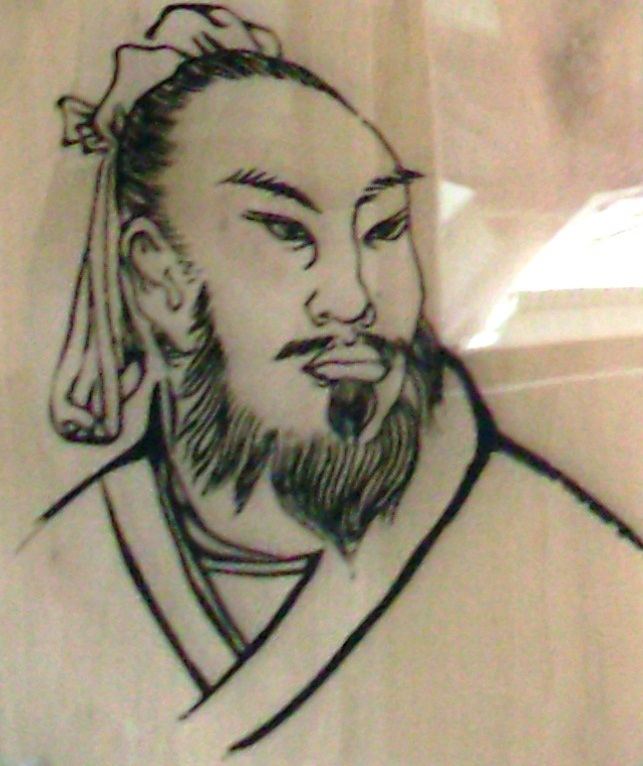 | ||
Gan Ying (Chinese: 甘英; pinyin: Gān Yīng; Wade–Giles: Kan1 Ying1), was a Chinese military ambassador who was sent on a mission to Rome in 97 CE by the Chinese general Ban Chao.
Contents
Although Gan Ying never reached Rome, only travelling to as far as the "western sea" which either refers to the Black Sea or the Parthian coast of the Persian Gulf, he is, at least in the historical records, the Chinese who went the furthest west during antiquity, and he gathered what information he could.
Gan Ying
Hou Hanshu

According to the Hou Hanshu, the Chinese history of the later Han Dynasty (CE 25-220),
"In the ninth year [97 CE], Ban Chao sent his Subordinate Gan Ying, who probed as far as the Western Sea, which is either the Persian Gulf or the Black Sea. and then returned. Former generations never reached these regions. The Shanjing gives no details on them. Undoubtedly he prepared a report on their customs and investigated their precious and unusual [products].""In the ninth Yongyuan year [97 CE], during the reign of the Emperor He, Protector General Ban Chao sent Gan Ying to Da Qin (大秦) [the Roman Empire]. He reached Tiaozhi (条支) (Characene) and Sibin (斯宾) (Susiana?) next to a large sea. He wanted to cross it, but the sailors of the western frontier of Anxi (安息) [Parthia] said to him:When [Gan] Ying heard this, he discontinued (his trip).The Hou Hanshu also recorded:
Description of Rome
Gan Ying also gave the following somewhat fanciful description of Roman customs and natural products undoubtedly based on what he was told by sailors in Persian Gulf ports:
"Their kings are not permanent. They select and appoint the most worthy man. If there are unexpected calamities in the kingdom, such as frequent extraordinary winds or rains, he is unceremoniously rejected and replaced. The one who has been dismissed quietly accepts his demotion, and is not angry. The people of this country are all tall and honest. They resemble the people of the Middle Kingdom and that is why this kingdom is called Da Qin [or 'Great China']. This country produces plenty of gold [and] silver, [and of] rare and precious [things] they have luminous jade, 'bright moon pearls,' Haiji rhinoceroses, coral, yellow amber, opaque glass, whitish chalcedony, red cinnabar, green gemstones, goldthread embroideries, rugs woven with gold thread, delicate polychrome silks painted with gold, and asbestos cloth. They also have a fine cloth which some people say is made from the down of 'water sheep,' but which is made, in fact, from the cocoons of wild silkworms. They blend all sorts of fragrances, and by boiling the juice, make a compound perfume. [They have] all the precious and rare things that come from the various foreign kingdoms. They make gold and silver coins. Ten silver coins are worth one gold coin. They trade with Anxi [Parthia] and Tianzhu [Northwest India] by sea. The profit margin is ten to one. ... The king of this country always wanted to send envoys to Han, but Anxi [Parthia], wishing to control the trade in multi-coloured Chinese silks, blocked the route to prevent [the Romans] getting through [to China]."
Analysis
Henry Yule described this account as "vague and puerile", but notes that it ended with a detailed description of the Mediterranean coral industry. Gan Ying travelled about the time that the Emperor Nerva adopted Trajan as his successor, but neither of them abdicated for bad omens; the "kings" according to him resemble the Sages of legendary Chinese antiquity more than any Roman institution.
The silkworms of the Greek island of Cos were cultivated in antiquity, but the product was never comparable to Chinese silk. However, this reference appears to be to the very rare and beautifully golden sea silk, which is also referred to in the 3rd century history, the Weilüe.
